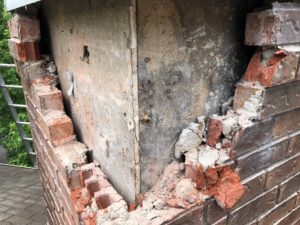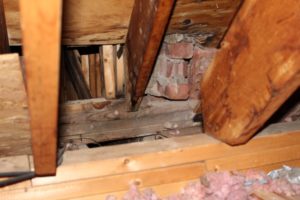The Art of Masonry Moisture Control: Considerations for Masonry Exteriors
Introduction to Masonry and Moisture
Contrary to popular belief, masonry leaks. This includes brick, CMUs (concrete masonry units aka cinder blocks), and all forms of veneer. Often, it’s the mortar that is to blame and more specifically, its current state of absorption or consistency. In this two-part article, I will cover what happens when you find yourself dealing with a masonry exterior, new or old, that has moisture intrusion issues in all its forms. The discussion is relevant and ongoing because it encompasses masonry in every application such as chimneys, walls (above and below grade), window and door rough openings, patio/paver decks, etc. The masonry applications that enclosure specialists deal with on a daily basis have to stand up to hydrostatic and hydrokinetic environments in the form of vapor, liquids and solids i.e. above and below grade water penetration, snow and ice loads, and of course frog strangling, forest gump sideways rain. If we can recognize a fundamental truth about masonry with all this in mind, then we can begin to pursue corrective solutions. The fundamental truth is that while it leaks, there is nothing wrong with masonry. It has everything to do with workmanship and design. The scope of this topic far exceeds this series and could be expanded upon even further. With that said, we’ll focus on what happens when you discover a leak in your masonry (Part 1) and tools that will help you decide what to do next (Part 2).
The standard masonry leak response goes something like this: You notice water where you hadn’t before. A torrential downpour results in ponding water inside of a building. There’s nothing you can do about it except pray for the rain to end while you dam up the water, grab some fans, and search for a shop vac to collect the puddles. The warning signs may have been there for a while such as a musty odor or saturated wall without ponding. Perhaps a spot of wet drop ceiling or drywall or the sound of a steady drip in your firebox emanating from the chimney. Whatever the warning sign there are also other more subtle signs of evidence that building enclosure specialists are particularly adept at catching such as flashings out of sequence, efflorescence or calcification, dysfunctional weep holes and organic growth, even the presence of insects near the point of water entry. Our attitude in identifying these early warning signs is that where there’s smoke there’s fire. Our job is to prevent that ember from becoming a smoldering inferno of inconvenience resulting in thousands of dollars in damages and lost revenue for our clients in the form of moisture intrusion.

Example of masonry moisture intrusion where a moisture barrier was not present at the time of original installation. This chimney had experienced leaks for 20 years and had 4 separate contractors attempt to fix it.
Masonry work is messy, expensive, invasive, and difficult, but it looks amazing, and everyone loves it. Sure, there are over cladding alternatives like metal panels, siding etc. and they have their place in the designer’s toolbox where necessary. However, in a place like Nashville, TN where cultural history and historical preservation are paramount, there must be options that will achieve the same results as adding additional coverage to the envelope without jeopardizing the structural integrity of the building or its curb appeal. There is nothing wrong with masonry. It has everything to do with design, intended use and the sequence/skill of installation. Much like entering numbers into a calculator, you will only get out of it what you put in. So, when you find yourself having to make the difficult decision of whether to repair or replace your masonry, you will often find a lot of conflicting information about the best ways to go about doing it which will sometimes end up making the problem worse and costing more money. At which point, you are better off burning your cash because at least it will keep you warm.
If you are considering masonry repair work and want to know more, I encourage you to read on for more details. If you find the subject matter confusing and complex that’s fine too. You can always call a trusted design or enclosure professional for an assessment. Another undeniable fact is that no matter how you look at it, resolution will cost you money. Rely on trusted professionals with proven experience that will help you spend that money as efficiently as possible. Unfortunately, if you find yourself reading this article out of necessity in response to active moisture intrusion, you’ll need to act fast as these problems never age well. What you must decide is what your building is telling you it needs at this moment and who you want on your team to interpret and deliver those needs.
First Thing’s First
We’ve had a mostly equal number of encounters with masonry failure in both residential and commercial applications, new and existing construction, above and below grade, vertical and horizontal applications. No matter the condition of the masonry or its intent, the decision-making process for corrective action is generally governed by three things:
1. Cost (what’s in the budget)
2. Service history (known history of maintenance and repair)
3. Aesthetics (will the repairs be obvious)

Example of an exterior masonry wall with moisture intrusion so extensive it had begun to rot the supporting framing headers and rafters causing significant structural damage.
Enclosure specialists will encourage you to evaluate your building conditions and test if necessary, to determine points of failure. The initial investigative phase of this process is essential to corrective action. Without proper diagnosis of the conditions and causes of moisture intrusion, any attempts at repair may be catastrophic to the building and the budget. Do not skimp or rush this step. Many people faced with deciding on construction repairs in general are more afraid of making the wrong decision than any other aspect of the project. That’s where your investigative team comes in. They will take all the factors listed above into account while providing documented evidence of their findings that will become a road map to success for all other contractors to follow.
When we receive an escalated request for inspection of a masonry building flaw, we immediately consider a series of questions:
- What is the service history of the project?
- What are the contract documents involved if any?
- Are as built plans available – what was the intended use in original design?
- What is the consistency of the leak and where exactly?
- What is access like, and can the area be tested?
- What testing methods are best suited to the situation?
- Who has the most intimate knowledge of the service history?
From there we plan to do a preliminary walkthrough and visual assessment of the site and inspect all the known conditions before considering any testing. The immediate goal, of course, is to stop the pain. The client has a serious leak and needs a plan of action with solid intel, but they also need the pain to stop while you address the issue. No one wants to be told that you are “evaluating all options” while their forced to invent creative new ways of explaining to their boss or tenant what’s being done to fix the problem. We aim to do so permanently and doing that takes time, but we also recognize the pain that wet buildings cause.
Continue reading for Part 2: The Surgical Procedure of Masonry Repair.








